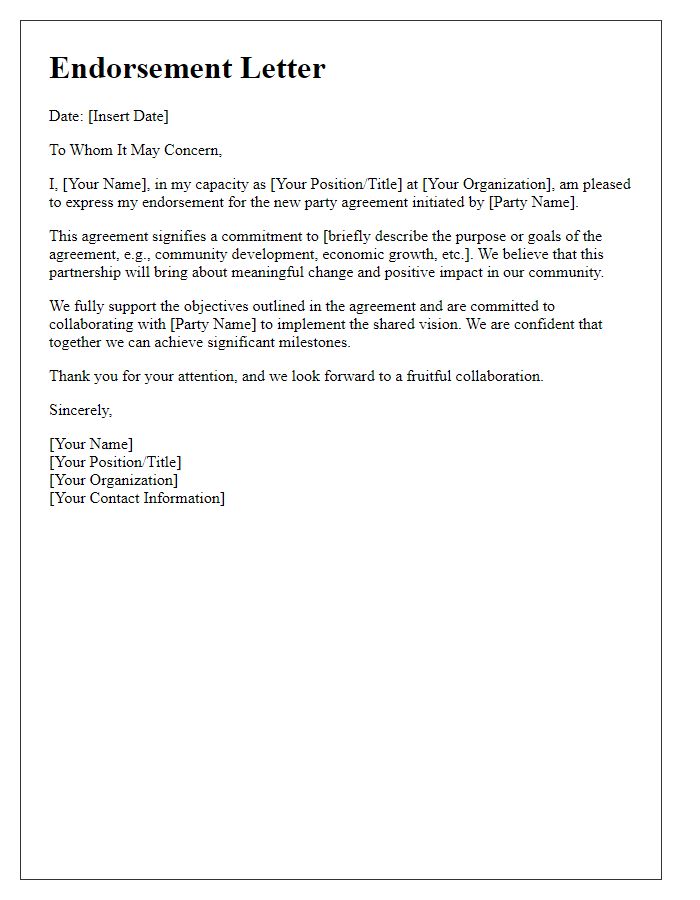Are you navigating the tricky waters of contract party replacement? It can often feel overwhelming, but crafting a clear and concise letter can make all the difference in ensuring a smooth transition. Whether you're replacing a party due to a change in business needs or unforeseen circumstances, having a structured template is essential. Stick around as we delve deeper into what to include in your letter and how to make it effective!

Clear identification of original parties and contract details
In a legal context, including a clear identification of the original parties to the contract is essential for establishing the framework of the agreement. The original parties, such as Company A, organized under the laws of Delaware, and Company B, based in California, would be named explicitly, alongside the contract title, dated April 1, 2022. Relevant details such as contract number, if applicable, and the specific provisions that are being amended or replaced should be clearly stated. The document must outline the effective date of the replacement and how the new party, Company C, incorporated in New York, fulfills the obligations and assumes the rights of Company A or Company B, ensuring legal clarity and continuity in business operations.
Explicit mention of the replacement party
In business transactions, contract party replacement involves the identification of a new entity to take the place of the original party in a legal agreement. For instance, if Company A, located in New York City, needs to replace their contract partner, Company B, the new entity would be specified clearly in the contract amendment. The new party, Company C, based in Chicago, must agree to all terms and obligations outlined in the original contract, including deliverables, timelines, and payment schedules. Proper documentation is crucial, including signatures from authorized representatives of both the original and new parties, ensuring all modifications are legally binding and enforceable.
Detailed explanation of the reason for replacement
A contract party replacement often occurs due to significant factors impacting the business relationship. For instance, unexpected financial difficulties stemming from market fluctuations may force a company to seek a more stable partner. Internal restructuring efforts can lead to personnel changes, causing a breach of continuity in contractual obligations. Legal issues, such as compliance failures with state regulations or federal laws, may necessitate finding a more reliable party to ensure adherence to the terms outlined in the original agreement. Furthermore, shifts in strategic direction, perhaps due to a merger or acquisition, could compel one party to replace another to align with new business goals. Incidents affecting reputation, such as negative media exposure or customer dissatisfaction, may also result in replacing a party to maintain trust and integrity in business dealings.
Official consent and authorization section
The official consent and authorization section of a contract party replacement document serves as a critical component for validating changes within the agreement. This section typically includes the names of original parties (entities or individuals) involved, providing foundational context. Clear identification of the replacement party is essential, detailing their legal name and registration information. Date of execution, often marked as a specific calendar date, signifies when consent is granted, while signatures of authorized representatives from all parties affirm agreement. Notarization may be required for added legal weight, often organized through local notary services. This section ensures that all parties are aware of the changes and formally agree to the terms outlined in the replacement contract.
Contact information for all involved parties
A contract party replacement requires precise communication. Essential details include the full names and addresses of all parties involved in the contract. This includes the primary signatory (for example, John Smith, 123 Main Street, Cityville), the replacing party (for example, Jane Doe, 456 Oak Avenue, Townsville), and any relevant affiliated parties. Contact information must encompass phone numbers (for real-time communication, such as John's number, +1234567890), email addresses (e.g., john.smith@email.com), and possibly alternative contacts (like a business manager). Clear identification of the roles (for instance, Contractor, Client) ensures smooth transition and execution of contractual obligations. Every detail matters to uphold legal integrity and transparency.













Comments